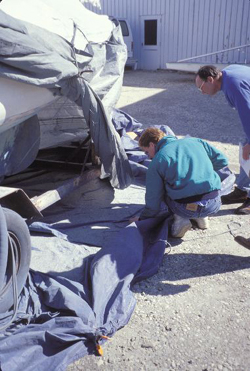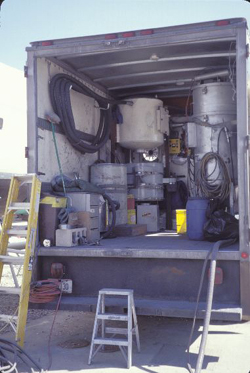New York Sea Grant's
Marina Pollution Prevention Web Site
Section 2: Painting
& Fiberglass Repair
- Abrasive Blasting:
Plastic Media Blasting
Plastic
Media Blasting
- Different
paint removal technologies can be used as BMPs to eliminate or,
at least, contain paint chips and dust associated with hull preparation
activities. Special equipment, products or procedures can also
help reduce the amount of waste material generated and ensure
it does not get into the environment.
New abrasive hull blasting technologies utilize a process to reclaim
and reuse media made of plastic. In this procedure, the boat must
be completely enclosed to trap the media and  paint
waste. The collected mixture is fed into specialized equipment
(located in the truck in the photograph) which through a sifting
process separates most of the paint dust and chips from the media,
which can then be reused. In addition to containing paint dust
and chips, this process can significantly reduce the amount of
material that has to be disposed of when stripping a hull. For
example, the plastic media stripping of a 19-foot boat produced
a total of 200 pounds of waste and media. The equipment recovered
185 pounds reusable media (containing a small amount of paint),
leaving only 15 pounds of paint for disposal. paint
waste. The collected mixture is fed into specialized equipment
(located in the truck in the photograph) which through a sifting
process separates most of the paint dust and chips from the media,
which can then be reused. In addition to containing paint dust
and chips, this process can significantly reduce the amount of
material that has to be disposed of when stripping a hull. For
example, the plastic media stripping of a 19-foot boat produced
a total of 200 pounds of waste and media. The equipment recovered
185 pounds reusable media (containing a small amount of paint),
leaving only 15 pounds of paint for disposal.
 Planning
Considerations Planning
Considerations
- Specialized equipment and training is required for plastic media
blasting.
- In some areas companies have mobile equipment and will
perform this service on site for a set fee.
- Containment of dust and other debris and recovery of the media
can considerably reduce clean up and disposal costs.
- Since the media can not remove anything harder than itself, these
techniques may not be effective for preparing all surfaces. For
instance, plastic media may not remove corrosion or barnacles
from props, shafts, or rudders. However, it will remove paint
without damaging sound gel coat, rubber, chrome or glass surfaces.
- Some softer media may not work well on very durable, pliable paints
(like coal tar epoxies). Paint around edges may have to be removed
by hand. Sanding is usually required before painting a blasted
hull.
- Care should be taken when blasting boats that have damaged or
blistered gel coats since blasting may open blisters or voids
that have to be filled before painting. Even sound gel coat may
contain small voids that may have to be filled after blasting.
Cost
Equipment costs for a blasting system that incorporates media
recovery and reclamation start at $25,000, not including training
or the media. In New York, contractors with their own mobile equipment
will blast hulls with plastic media on site for approximately
$17 to $18 per foot, where length is calculated as the length
of the boat at the waterline plus one-half the beam. (Approximate
cost for blasting a "typical" 30-foot power boat is
about $630.) Discounts may be available for volume work.
|

